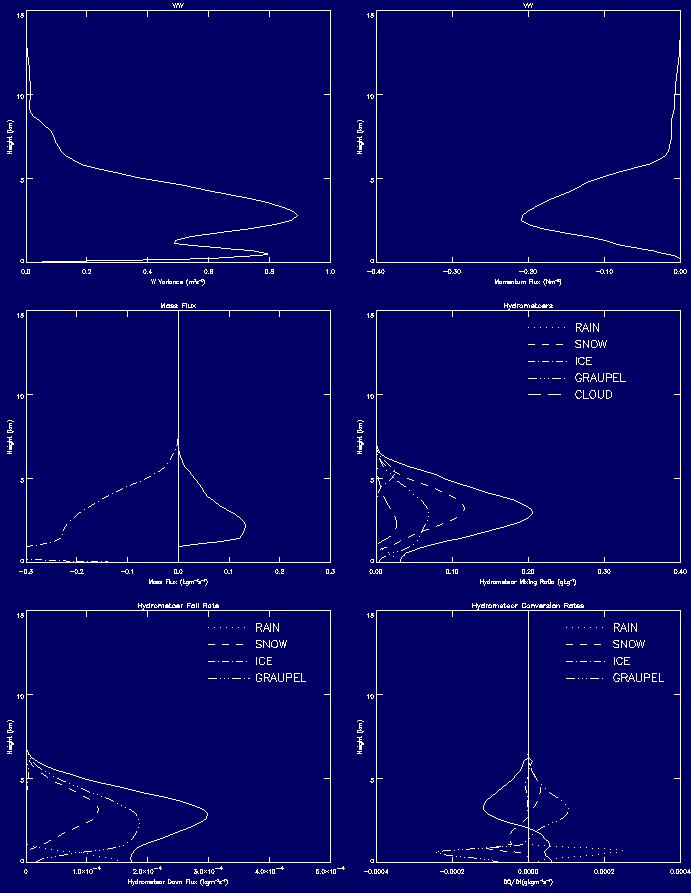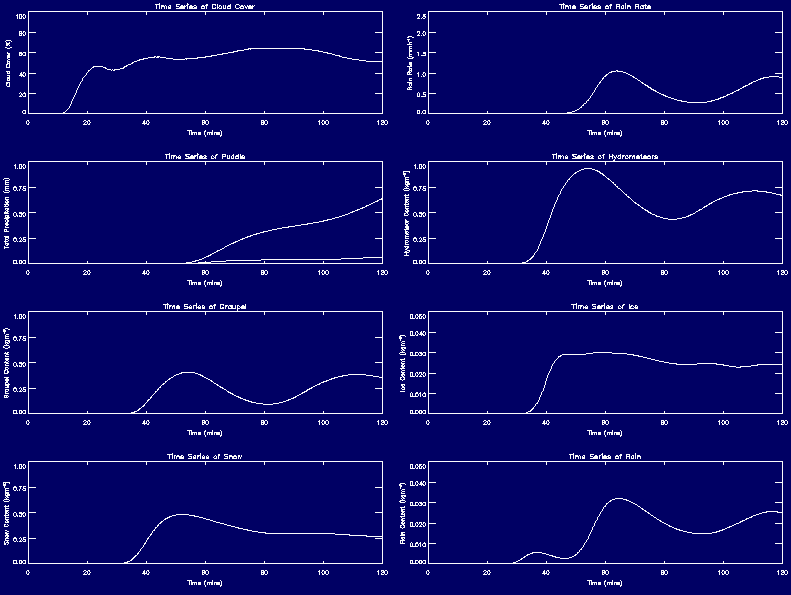|
Test Case 5: Cold air outbreak
This test case is 3D and does not require the radiation code.
This page provides the background information on test case 5 and
examples of run of test case 5 on various machines.
Background information (from Jon Petch)
As well as tropical deep convection (e.g. TOGA-COARE) and mid-latitude
summer deep convection (e.g. ARM) the LEM can also be used to study
convection in colder atmospheres. Whereas in the tropical and summer
cases the melting level is high and nearly all surface precipitation
is rain, in the colder atmosphere the melting level will be much lower
and frozen hydrometeor species, particularly graupel, may contribute
to the surface precipitation. Such a convective cold atmosphere case
is referred to as a "cold air outbreak" and represents, say, a
northerly cold plunge over mid-latitude oceans or springtime land. The
convection is essentially surface forced, as the relatively warm land
or sea heats the boundary layer and makes the atmosphere convectively
unstable.
This cold air outbreak is an idealised case used by Kershaw (QJ,
1995) and Kershaw and Gregory (QJ, 1997). A simple thermodynamic
profile and vertical wind shear and specified along with constant
prescribed sensible and latent surface heat fluxes of 100 W/m2 and
400 W/m2 respectively. The model is initiated with low level random
noise, and no other forcing (such as radiation) is present. Within an
hour convection is established and timeseries and the typical mean
properties over the second hour are shown below:


Profiles from the final hour.
Typical timeseries.
The original case in Kershaw (1995) used only warm rain
microphysics. However, the case presented here is used primarily as a
test of the three phase double moment microphysics and deep convection
in a 3-D domain.
Files required to run test case 5
The files needed to run this test case can be found in
/home/lem/VER2.3/TEST_CASES/TEST5_2.3 and the table below indicates
which files you'll need for which machines
|
Turing (T3E - no longer available) |
Department machines |
Origins (i.e. wren, fermat or green) |
Newton |
| run...f |
runTEST5_2.3.f |
runTEST5_2.3-m.f |
runTEST5_2.3.f |
runTEST5_2.3.f |
| end...f |
endTEST5_2.3.f |
endTEST5_2.3.f |
endTEST5_2.3.f |
endTEST5_2.3.f |
| nmlsetup... |
nmlsetupTEST5_2.3 |
nmlsetupTEST5_2.3 |
nmlsetupTEST5_2.3 |
nmlsetupTEST5_2.3 |
| nmlchain... |
nmlchainTEST5_2.3 |
nmlchainTEST5_2.3 |
nmlchainTEST5_2.3 |
nmlchainTEST5_2.3 |
| model... |
modelTEST5_2.3 |
modelTEST5_2.3 |
modelTEST5_2.3-n |
modelTEST5_2.3-n |
Runs for Test Case 5
| Computer |
Run No |
Version |
PEs |
IIP, JJP, KKP |
Time Taken |
Results |
| Newton |
131 |
2.3 |
16 |
128, 128, 60 |
1.90 hrs |
The final hour
Timeseries
|
| Origins |
31 |
2.3 |
16 |
128, 128, 60 |
~6 hrs |
The final hour
Timeseries
|
| GRID |
56 |
2.3 |
1 |
40, 40, 60 |
20.0 hrs |
The final hour
Timeseries
|
| T3E at Met Office |
N/A |
2.2 |
16 |
128, 128, 60 |
unknown |
The final hour
Timeseries |
| Turing |
708 |
2.2 |
16 |
128, 128, 60 |
unknown |
The final hour
Timeseries |
|



